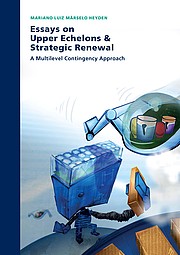Essays on Upper Echelons & Strategic Renewal: A Multilevel Contingency Approach Defended on Thursday, 10 May 2012
To survive and prosper firms have to renew their strategies to maintain a dynamic strategic fit with their changing environments. Strategic renewal can be understood as the adaptive choices and actions a firm undertakes to alter its path dependence and maintain a dynamic strategic fit with changing environments over time. In this dissertation we endeavor to develop and test theory on how, and under what environmental, firm, and team conditions, the organization’s key decision makers –its Upper Echelons, pursue particular adaptive responses. We focus on some contingencies that prompt Chief Executive Officers (CEOs), Top Management Teams (TMTs), and Middle Managers (MMs) to adapt through internal and/or external modes of renewal. We propose that heterogeneity in adaptive strategic choices ensues from the contingent search patterns (behavioral, cognitive, and informational) adopted by the organization’s Upper Echelons. In the first study we find asymmetric behavioral search patterns of CEOs in relation to different cross-level correlates. In study two we find that TMT attributes influence cognitive search-focus in dynamic environments to explain heterogeneous adaptive responses. In the third study we find that TMT and MM attributes can either enable or hamper changes in structures, processes, and practices. Study four exposes how the complex interaction between TMT diversity and shared TMT vision drive new knowledge creation from the stock of knowledge acquired through informational search activities by TMTs. The findings from the four studies, each adopting a unique database, provide evidence on how contingent search patterns of Upper Echelons drive different modes of renewal.
Keywords
upper echelons, strategic renewal, top management teams, CEOs, middle managers, contingency theory, multilevel, environmental dynamism, diversity, shared vision, content analysis













